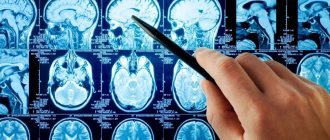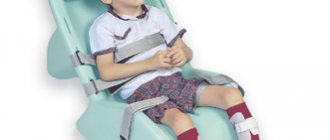Pinchuk Elena Anatolyevna
Deputy chief physician for medical work, kmn, neurologist, doctor of physical and rehabilitation medicine
Lipovka Nadezhda Sergeevna
Head of the Department of Medical Rehabilitation, Physician of Physical and Rehabilitation Medicine, Neurologist
A decrease in standard of living after a stroke is a fairly common complaint among patients who have ever suffered from this condition. At the same time, residual effects after a stroke can negatively affect such areas of a person’s life as psychological, physical, and social.
Consequences and residual effects largely depend on the speed of detection of the disorder, as well as on the effectiveness of treatment and subsequent rehabilitation. It is also worth noting that full recovery may not occur due to the severity or type of impairment, the location of the stroke, or multiple brain injuries. Residual effects after a stroke can interfere with the patient's return to normal life.
Possible complications that may occur in patients after treatment and rehabilitation include:
- aphasia;
- difficulty moving;
- cognitive problems.
Why does a stroke occur?
Ischemic stroke (ischemia is a decrease in blood flow) develops due to blockage of a vessel that supplies blood to an area of the brain. Most often, the vessel is blocked by a blood clot that formed locally or was brought by the blood flow from another organ. A thrombus is a blood clot, the formation of which the coagulation system responds to damage to the vascular wall. In order for a blood clot to occur, there must be prerequisites - atherosclerosis, diabetes mellitus, varicose veins, hypertension or other conditions in which the inner wall of the vessel is damaged. Massive thrombus formation begins only on the vessel wall, which has lost its smoothness, is pitted and ulcerated. Most often, blood clots form in the cerebral arteries, namely the middle cerebral artery, and in the vessels and cavities of the heart. Not only a blood clot can come off, but also a piece of atherosclerotic plaque (microembolism). A blood clot never forms in a healthy vessel.
At CELT you can get advice from a neurologist.
- Initial consultation – 4,000
- Repeated consultation – 2,500
Make an appointment
Risk factors – condition or cause?
The existing concept of risk factors (there are more than 80 of them!) establishes mathematically reliable connections between diseases (hypertension, atherosclerosis), syndromes, life circumstances and the occurrence of stroke. However, risk factors are only conditions that contribute to stroke, but are not its causes. Is it possible to prevent it by overlooking the causes of a disease? I think the answer to this question is obvious. As for the reasons... Frankly speaking, many doctors still do not delve too deeply into this problem. Obviously, they are waiting for an official form to land on the table with a clear indication of where to hit in order to save humanity from a serious illness. Meanwhile, the cause of stroke, back in the 80s of the now past century, was formulated by the outstanding Russian cardiologist I.K. Shkhvatsabaya. The patient's medical history can be aggravated by many risk factors - atherosclerosis, coronary heart disease, he may live in an environmentally unfavorable or stressful atmosphere, smoke and abuse alcohol... However, until a specific vascular situation arises, which is defined as a hemodynamic crisis, there will be no stroke .
How are strokes classified?
The classification is based on clinical manifestations and their duration. Neurologists distinguish the following periods of stroke development:
- the most acute is the first 3 days. If symptoms regress after 24 hours, a transient ischemic attack (TIA) is diagnosed. In the most acute period, the leading importance is given to the first three hours after the manifestation of a cerebral catastrophe - the so-called therapeutic window (it is during this period of time that it is possible to actively and radically influence the course of a stroke through thrombolytic therapy);
- acute – up to 28 days. If the neurological deficit regresses before 21 days, then this condition is regarded as a minor stroke;
- early recovery – up to six months;
- late recovery - up to 2 years;
- the period of residual manifestations is more than 2 years.
Depending on the mechanisms of occurrence and course of the disease, the following types of stroke are distinguished:
- Atherothrombotic stroke, which occurs in 34% of cases and, as a rule, develops against the background of atherosclerosis. In this case, the symptoms of the disease intensify over several hours or even days.
- Cardioembolic stroke occurs in 22% of cases when a cerebral artery is completely or partially blocked by a blood clot.
- Lacunar stroke - usually caused by damage to small arteries, often accompanied by increased blood pressure. The incidence of this type of disease is 20%.
- Hemodynamic stroke is a consequence of a decrease in blood pressure or a drop in cardiac output. This type of disease occurs in 15% of cases.
- In 9% of cases, a so-called rheological stroke occurs, which is caused by severe disturbances in blood flow, as well as disturbances in the process of dissolving blood clots and the bleeding control system.
Rehabilitation
The Yusupov Hospital has developed special programs for recovery after a stroke. A team of doctors and rehabilitation specialists works with the patient. The main goal is to restore the activity of brain cells that died during an ischemic stroke and help the patient independently take care of himself in everyday life.
During the early recovery period of ischemic stroke, a course of drug treatment continues, in addition, measures are prescribed to restore lost functions:
- methods are used that increase sensitivity;
- classes are conducted with a speech therapist aimed at correcting the patient’s speech defects;
- Therapeutic gymnastics are prescribed to strengthen muscles and ligaments.
During the early recovery period, the patient still needs constant assistance from the medical staff of the Yusupov Clinic, since performing basic actions independently is still, as a rule, inaccessible to him.
In the late recovery period (after 6 months), the skills developed during the early recovery period of ischemic stroke become noticeable. There is a partial restoration of fine motor skills and sensitivity in the fingers of the upper and lower extremities.
Rehabilitation specialists at the Yusupov Hospital continue to work aimed at developing sensitivity in the limbs, and the patient continues to do gymnastics.
During the period of residual effects of stroke (from 12 to 24 months), the patient must follow the recommendations of the attending physician, aimed at maintaining and improving the achieved results, as well as preventing relapses of the disease.
The recovery process proceeds most effectively under the supervision of specialists from the Yusupov Hospital: neurologists, rehabilitation specialists, psychologists, cardiologists and physiotherapists.
How does a stroke occur?
Many people have warning signs on the eve of a vascular accident in the form of a headache, numbness in an arm or leg, dizziness, or “fog” in the head. These symptoms pass quickly, sometimes lasting only a few minutes. They mean that the patency of the blood vessels in the brain has worsened.
Nature protects the brain, as the main regulator of life, from damage as much as possible. At the base of the brain there is the so-called Circle of Willis, described more than 300 years ago. This is the connection of two carotid and two vertebral arteries that supply blood to the brain. Its purpose is to compensate for blood flow. If a blockage occurs in one of the 4 arteries, the blood flow is redistributed from other main vessels.
When short-term symptoms appear and disappear, this means that an incomplete blockage has occurred, and the blood supply is carried out through collaterals or bypass routes. Unfortunately, people rarely pay attention to the harbingers, mistakenly believing that since it has “passed”, then there is nothing to worry about. This is not the case with stroke warning signs. If doctors had the opportunity in this short period to “regulate” blood circulation, reduce blood viscosity and swelling of brain tissue, then the risk of stroke could be minimized. If you do nothing, then in a few days a complete blockage of a large vessel may occur.
Thrombosis or embolism occurs acutely, a person may fall and lose consciousness or wake up in the morning with an arm or leg no longer functioning, speech impairment, weakness and lack of understanding of what is happening around.
Aphasia
One of the disorders caused by a stroke can be aphasia, which is one of the main symptoms of damage to the language center of the brain located on its left side. After a stroke, people with aphasia may experience the following symptoms:
- difficulty in choosing the right words;
- difficulty understanding speech, etc.
Some symptoms may disappear completely over time, while others will remain with patients for life. In most cases, doctors are able to restore language understanding more easily and quickly than the patient’s vocabulary or other speech limitations.
Location of stroke
Diagnosis of ischemic stroke has only begun in recent decades using neuroimaging, but neurologists learned to determine the location of the lesion several centuries ago. The blood supply to the brain is designed in such a way that each vessel supplies blood to a specific area, and by the loss of functions it is possible to determine which vessel and part of the brain is affected.
When a vessel is blocked, a section of brain tissue softens. This condition is called cerebral infarction. Determining the location of the lesion based on symptoms is a topical diagnosis, the basis of neurology.
During a stroke, there are general cerebral and focal symptoms. General cerebral – the body’s response to the death of neurons. These are headache, loss of consciousness, drowsiness or drowsiness, nausea or vomiting, pain when moving the eyeballs. Some strokes may cause generalized (spreading throughout the body) seizures. The vegetative system is also upset - there is a feeling of heat, palpitations, dry mouth, sweating.
Focal symptoms are specific dysfunctions: paralysis, paresis (weakness), blindness, muscle tone disorders, urinary incontinence and others.
Symptoms of damage to various vessels:
- middle cerebral artery (accounts for 80% of all strokes) - paralysis of the arm and leg on the side opposite to the blockage, loss of visual fields, inability to speak or make purposeful movements;
- anterior cerebral artery - paralysis of the leg on the side opposite the blockage, involuntary grasp reflex, spasticity or sudden increase in muscle tone, loss of balance due to which the person cannot walk, persistent repetition of any action (phrase, emotion, activity), incontinence urine;
- posterior cerebral artery - partial blindness may develop along with memory loss or damage to the oculomotor nerve in combination with paralysis of one half of the body and impaired coordination of movements.
- internal carotid artery - paralysis in an arm or leg, sometimes in both limbs on one side, blindness in one eye on the opposite side, inability to speak;
- vertebral arteries - unsteadiness when walking, paralysis or weakness on one half of the body, disturbance of friendly eye movements, involuntary twitching of the eyeballs, inability to control the facial muscles, difficulty swallowing, hearing loss, sometimes coma.
There is also a lacunar cerebral infarction or softening of a small area of the brain up to 2 cm, which is manifested by weakness in the arm, leg, and facial muscles.
A fatal coincidence...
Hemodynamic crisis is an acute disturbance of systemic or regional hemodynamics, leading to dysfunction or damage to the brain. Hemodynamic crisis develops as a result of decompensation in the heart, rhythm disturbances, sudden changes in vascular tone, increased blood viscosity, intravascular thrombus formation, and activation of atherosclerotic plaques. And more often, a hemodynamic crisis is the result of a combination of circumstances (stress, geomagnetic storms and atmospheric pressure fluctuations, dietary errors, exposure to extreme factors, etc.) that disrupt the balance in the system of regulation of blood supply to the brain. Hemodynamic crises are the causes of acute cerebrovascular accident (ACVA), since they are directly related to the development of stroke. Modern research methods make it possible to identify and clinically identify several types of hemodynamic crises: hypertensive, hypotonic, coronary, arrhythmic, angiodystonic, hemorheological, neuroendocrine and obstructive
.
Our doctors
Novikova Larisa Vaganovna
Neuropathologist, Candidate of Medical Sciences, doctor of the highest category
Experience 39 years
Make an appointment
Pankov Alexander Rostislavovich
Neurologist
40 years of experience
Make an appointment
Diagnostics
MRI of the brain
- Cost: 14,000 rub.
More details
Diagnosis, as a rule, begins with an examination by a neurologist, assessment of clinical symptoms and analysis of the history of the disease. Of course, both laboratory and instrumental diagnostic methods are used. The main emphasis is on identifying pathology of blood vessels and areas of softening of the brain. From the moment of blockage in the tissues, a biological reaction begins, which is called the “ischemic cascade”. Its development is accompanied by the formation of an infarct nucleus, apoptosis of brain cells and secondary diffuse cerebral edema. MRI in vascular mode, ultrasound Dopplerography of blood vessels, angiography, scintigraphy or study of the brain after the introduction of radioisotopes, positron emission tomography or study using radionuclides are used.
Treatment of ischemic stroke
Treatment of any stroke is a complex matter, which does not always end successfully. Doctors try to reduce the softening zone with the help of medications. At the time of a vascular accident, it is necessary to maintain vital functions - heart function, breathing, metabolic processes. Massive infusion therapy and the use of an artificial respiration apparatus are required. All this is done in a hospital, sometimes in the intensive care unit. It is often possible to dissolve a blood clot with medications. However, the event has already happened, and not everything can be returned to its previous level.
From the moment the condition stabilizes, restorative treatment is required, aimed at restoring lost functions. In recent years, it has been proven that the brain has neuroplasticity - nerve cells are able to “retrain” and change specialization. When the cells that controlled movements die, their function is taken over by “neighbors” who were previously doing something else or were inactive. For this purpose, physical therapy techniques are used.
To prevent a stroke, you need to consult a neurologist if unknown disorders appear - persistent headache, clumsiness in the hand, speech impairment, forgetfulness, blurred vision, high blood pressure. It is possible to prevent ischemia, but this requires timely consultation. Life without restrictions is possible if you take care of it.
Make an appointment through the application or by calling +7 +7 We work every day:
- Monday—Friday: 8.00—20.00
- Saturday: 8.00–18.00
- Sunday is a day off
The nearest metro and MCC stations to the clinic:
- Highway of Enthusiasts or Perovo
- Partisan
- Enthusiast Highway
Driving directions
Look for the reason in the heart
Coronary crisis is a consequence of acute coronary insufficiency. More often it occurs with obvious signs of angina, but sometimes in the form of silent myocardial ischemia. In any case, a coronary crisis can lead to hemodynamic disturbances directly related to brain damage. Arrhythmic crisis (paroxysmal forms of cardiac arrhythmias) is one of the main causes of cardioembolic and hemodynamic stroke. At least 20% of strokes are caused by cardioembolism. The mechanism of brain damage during arrhythmia is associated with a sharp decrease in the pumping function of the heart during the period of arrhythmia, or with the release of thrombotic masses that form in the chambers of the heart into the arteries of the brain.








